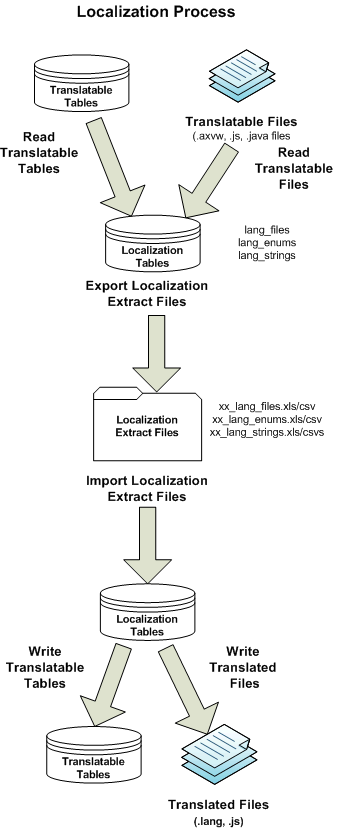Localization Process
The Archibus localization process centers on using the Localization Toolkit in Web Central to manage the translation of all the application text strings, menus and messages. The current system manages translations to five key European languages, French, German, Spanish, Italian and Dutch and two Asian languages, Chinese (traditional and simplified) and Japanese.
The key components of the Toolkit are:
-
Sybase SQL Anywhere Version 12.0 Software.
-
Localization database in the Sybase SQL Anywhere format so as to support both double byte and single byte characters.
-
Localization Toolkit in Archibus Web Central connected to the Sybase localization database.
Overview of the Localization Steps
The localization process includes the following steps:
- Read: First the program reads all strings from translatable tables and translatable files into the localization tables.
After reading these strings, the localization tables have all strings in the software. If you fill in the translatable values in the lang_files, lang_strings, and lang_enum tables, you can write the values back to the tables and files and have a complete translation.
- Export: A common step is to export the localization tables to Excel, so that they can be sent to a professional translator for the first-pass translation. This step is useful when working with external translation houses, as their translation software (for example, Trados) can work directly on the Excel file, automatically translate duplicates, and make use of any translation memory created in previous translation rounds.
Note: If you are exporting just to import the strings into another database, use Comma-Separated Values Format (CSV) instead of XLS format.
- Import: After the strings are translated, import them back into the localization tables.
- Write: Write the strings back to the translatable tables, and write the lang, and .js files for Web Central.
- Build: Only if you are localizing the Smart Client, build the .resx file into a resource .dll.
Note: If you are managing both single-byte (for example, French or Spanish) and double-byte (for example Chinese or Japanese) languages, you need to use a Sybase database. This is because Microsoft SQL CHAR and VARCHAR datatypes do not support both single-byte and double-byte character sets in the same database. Additionally, you cannot use Oracle because it has other limitations that are not supported by the Localization Kit functionality. Sybase documentation was removed from online help beginning with V.2023.02, but you can access it in the archived V.2023.01 System Management Help.
High-level View of the Localization Process
The following diagram gives a high-level view of the localization process:

See Also